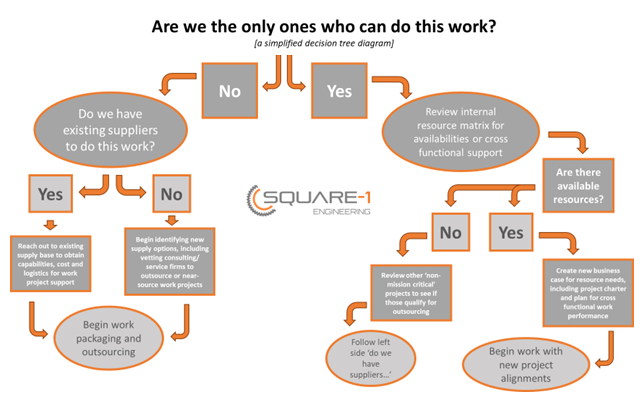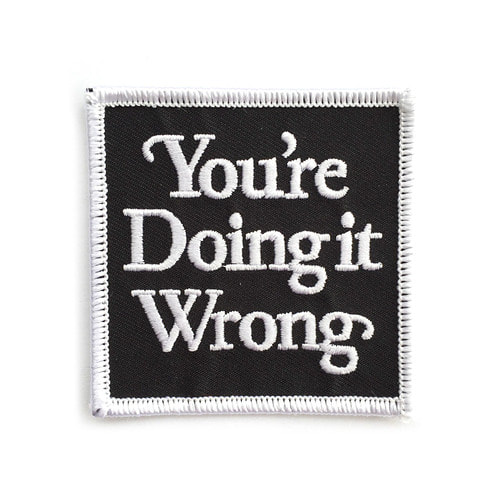|
We’ve all experienced it – too much work, not enough time or resources to complete it. Day after day passes, the work doesn’t slow down but your timeframes become shorter and shorter furthering the stress of the looming workload. All companies, start up to conglomerate, experience this same situation. They’ve got work they can’t get to given the circumstances of their business. Usually it’s…
We can all agree we’ve seen this first hand and very well may be living it now within our current companies. The key question then becomes, “How do we address the ‘too much work, not enough [blank]’ commonality we all share?” First, we need to assess the work in question and is it mandatory to keep close to the chest? Meaning, are we the only ones who can do the work? If your answer is: NO – “the work can be done by someone else”; we should begin looking for alternative means for getting the work done via our supply base or strategic partners. First, review your existing base of suppliers and their capabilities to see where work can be sent out. Second, identify firms which provide outsource services. Many times the word ‘outsourcing’ is used as an all encompassing description for service providers that offer project or work package support, often which can be done onsite with the client just as easily as offsite – which would be the traditional method of outsourcing. YES – “the work can only be done by our organization”; we should review the matrix of resources versus project loads. Undoubtedly there are resources within the organization that aren’t working at full capacity and or are assigned to projects which aren’t immediate. The trick with this approach is it may not satisfy the situation long term, often times when we try to keep things in house all we do is push off the situation to a later date. If that doesn’t work, test your bias on ‘the work can only be done by us’. If you are in fact going to consider using an outsourcing or consulting firm to support you in your work projects be sure to follow this simple three step process to ensure you’re picking the right partners:
Key Take Away: Sometimes the best business decision we can make is deciding what work we want to do [internally] to increase our capacity and efficiencies while outsourcing work to suppliers or service providers which specialize in project work. In turn, this means we can focus on the mission critical work, that we enjoy and are great at doing while giving someone else the work and or projects we can’t handle or don’t want to deal with. Action Item: Utilize the below decision tree diagram (yes, it’s overly simplified) to help you determine if the work you have in question should stay internally versus would benefit from being handled by an outside source. Are you looking for an outside services firm to help you with your projects? If so, our company Square-1 Engineering, would be happy to speak with you about your needs. Check us out and let us know how we can help by clicking HERE.
0 Comments
Monday Quickie - You're Doing It Wrong7/22/2019 “They gave us world class, but all we needed was the basics.”
Last week I was speaking with a VP of Quality at a small medical device company at which point he politely complained to me about a recent experience he had with a consultant their company brought onboard. The company was implementing a new online quality management system (QMS) and was utilizing this consultant to get it up and running. The VP shared with me his irritation about how the consultant came in and took on the project as an expert in the field. The consultant had done many QMS implementations prior and came with good recommendations of his work. As the conversation went on the VP share further irritation about his experience working with the consultant. He brought in an expert to do a job that was rather straight forward yet that’s not what the company got in the end. Unfortunately, the consultant failed to understand one of the most important aspects of his job – understand the needs of the customer and implement accordingly. “We’re a small company, we don’t need all the bells and whistles right now [from a QMS system]. We just need a system that keeps us in compliance while making things easier from a process flow standpoint.” The VP was sharing with me a painful experience he was having as a result of someone doing work for him and not understanding what was actually needed in the moment to be successful on that project. Sometimes what’s needed is the basics, not world class. The key is knowing when each of these is appropriate. All to often we show up to a project or work with the idea we’re going to dress up the proverbial pig ready for a fancy night out on the town. This pig of ours is going to look amazing, amazing because of the work we did to get it there. However, we end up missing the mark because we don’t bother to ask the right questions along the way. If we had bothered to ask the right questions to understand what was truly needed by the company and the key stakeholders we may find out the ‘pig’ just needs a new pair of shoes, not a whole wardrobe change. Here’s how this played out in the scenario above with my client and VP…
Here’s the rub on the situation. If the consultant had bothered to ask the vital question of their client upfront “What does ‘success’ looks like at the end of the project?” he would have found out the client needed a practical QMS which met the basic needs of their product and regulatory requirements yet did not need a lot of the fancy bells and whistles larger companies utilize with their QMS. Basically, this small medical device company needed a QMS that was straightforward, basic yet allowed them to upgrade their company to meet the regulatory requirements for their product. The client wanted a no frills, basic system yet what they got was a world class system they’ll probably never fully utilize. Key Takeaway: Don’t assume your work or project requires you to put forth world class service. Sometimes ‘good enough’ is all that’s needed. Knowing the different between ‘good enough’ and world class work outputs is a vital skill to develop and implement in your career. Action Item: Before you begin your next project at work think to yourself “what’s really needed here? The basics or something more?”. Then actually go ask the key stakeholder in charge. Doing this shows an ability to think big picture with an appreciation for what’s best for the company, not what’s best to make you look good as a result of the work you can do. Monday Quickie – When to Let Go of Work6/24/2019 We’ve all experienced it – too much work, not enough time or resources to complete it. Day after day passes the work doesn’t slow down but your time frames become shorter and shorter furthering the stress of the looming workload. Knowing when to let go and ask for help is a supremely important skill to develop. Too often we don’t ask for help, we bury our heads in the sand thinking if we put in more hours it will magically work itself out. Sound familiar? When we’ve got too much work it often shows up like this…
We can all agree we’ve seen this firsthand and very well may be living it now. The key question then becomes, “How do we address the ‘too much work, not enough [blank]’ commonality we all share?” as mentioned above. First, we need to assess the work in question and whether or not it is mandatory to keep close to the chest. Meaning, are we the only ones who can do the work? If your answer is: NO – “the work can be done by someone else”; we should begin looking for alternative means for getting the work done via our supply base, strategic partners or find a lacky within the company to dump it on. Don’t pretend like you haven’t done this or at least thought about it. First, review your existing base of suppliers and their capabilities to see where work can be sent out. Second, identify consulting firms which provide outsource services. Many times the word ‘outsourcing’ is used as an all encompassing description for service providers that offer project or work package support, often which can be done onsite with the client just as easily as offsite – which would be the traditional method of outsourcing. YES – “the work can only be done by me”. I’ll caution you here. Often times our egos tell us that we’re the only ones who can do it. We’re the only ones who can rise to the occasion. We’ve got the legacy information therefore we need to do the work. This often times is not the case, we just haven’t spent enough time or effort understanding what our options are. That and perhaps we’re a little stubborn. If you’ve done some discovery and still came up empty handed believing you’re the only person to do the job(s) then it becomes a process of prioritization. If you have a lot of work you’ll likely not be able to hit all your deliverables and or deadlines so it’s important to prioritize based on stake holder expectations, company critical milestones and your own sanity. If you don’t have any looming deadlines I like to pick off an easy project first to feel good about my ability to finish a task then switch it up and go after a tougher one. This keeps me motivated to do the work even though I know the pile of work in front of me is a tad insurmountable. A couple months back I was called by a client who had a similar ‘too much work, not enough time’ problem. As I listened to their situation I could literally feel their pain coming through the phone. They were on red alert. Their engineering teams had been working at max capacity for months and only made a small dent in the projects they were working on. As more time passed someone was able to get through to management having a ‘come to Jesus’ conversation. As a result, the company final acquiesced to the fact that their teams couldn’t handle the work and they weren’t going to hit their deadlines. This is precisely why I got phoned. The call was nothing short of “bail us out, we’re drowning in our own sorrows” type of call. Okay, perhaps my account of the situation is a bit hyperbolic, yet it’s not so far off the reservation. Fact is they had too much work and not enough time OR resources to deal with it and since my company is already an approved supplier it made it easy for their engineering manager to pick up the phone, make one call, and get the help they needed. They were finally at a point where they could let go. Our team over a two week period worked through 200+ component drawings helping our customer meet their deadline while keeping their team operating at a realistic pace. When the project was over I asked the customer why they waited so long to ask for help [regardless of the fact they came to us for that help]. Their response was simple and certainly not surprising. “We thought we could handle it but by the time we realized we weren’t going to hit our deadline we were already too deep into the project to turn back. My team was burnt out from the overtime and we just couldn’t ask more from them.” It was a valuable reminder to say the least. If at all possible, identify sources for support BEFORE you need them. While our client in this particular situation got lucky and was able to depend on a trusted supplier to help them out, often times the outcome of similar situations doesn’t produce the same results. Next time you’re in over your head will you remember to let go and ask for help? Key Take Away: Sometimes the best business decision we can make is deciding what work we want to do [internally] to increase our capacity and efficiencies while outsourcing work to suppliers. In turn, this means we can focus on the mission critical work, that we enjoy and are great at doing, while giving someone else the work and or projects we can’t handle or don’t want to deal with. The key piece is to be able to identify when you need to step aside and ask for help before it’s too late. Action Item: Challenge yourself to really look at your work and performance. How does it add up? Are you or your team working effectively? Do you need to pause and consider whether or not it’s time to ask for help? Jot down a list of activities or projects you’re working with and or will be taking on in the near term. Identify which of those projects are mission critical and which are important but able to be done at a later time or by someone else. Establish a support system of suppliers, other departments within the company or external consultants you can call on at a moments notice to help you out of a jam. Get these relationships fully vetted proactively so when you need the help your support system is ready to go. Now – breathe easier and send the Square-1 a thank you note for the advice. Life is better when we’re prepared. About the AuthorTravis Smith is the founder and managing director of Square-1 Engineering, a medical device consulting firm, providing end to end engineering and compliance services. He successfully served the life sciences marketplace in SoCal for over 15 years and has been recognized as a ‘40 Under 40’ honoree by the Greater Irvine Chamber of Commerce as a top leader in Orange County, CA. Categories
All
Archives
April 2024
|
Visit Square-1's
|
|





 RSS Feed
RSS Feed


